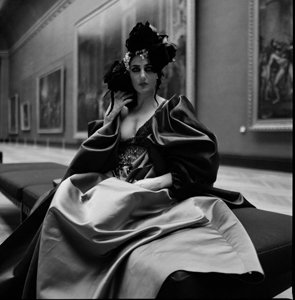Joseph Dadoune-Sion
A Cinematic Trilogy, Curator: Drorit Gur Arie
06/11/2007 -
26/01/2008

The project Sion (2002-07) fuses Dadoune’s previous films in terms of the issues with which he is concerned and the mental components distinguishing his world. At the same time, however, it presents a more intricate situation and takes a more explicit stand which does not seek mending and reconciliation. The work consists of two films under a single title: a 12-min b/w film which was screened at the Paris Louvre Museum in 2006, and an hour-long color film making its world premiere in the current show. Shot in [the southern town of] Ofakim, the West Bank Jewish settlement of Teqoa, Jerusalem, and the Louvre Museum in Paris, the work addresses the fate of the lamenting, maternal, exiled, persecuted, rebellious and punished Sion. Sion is a personification of Jerusalem, enacted by actress Ronit Elkabetz as a multi-faceted woman with numerous identities and mindsets – the main character that sets the plot in motion. With a unique visual language combining spiritual cinema with art, Dadoune sketches an allegorical piece about Jerusalem, with all the burden of history carried on its shoulders, a weight that often left it wounded and bruised, and yet – a proud eternal entity.
Jewish history, primordial landscapes, the Judean desert and the Negev, the sights of the town of Ofakim – all these assume a new dimension of power and strength that culminate in a political-cultural act formulated through a performance taking place inside the Louvre – a powerful institution and the very heart of the Western cultural establishment. With a meticulous aesthetic design and a cinematic language rich in imagery, Dadoune situates the Jewish position at the forefront of his artistic statement. Using the Hebrew text and a distinctive Hebrew typography supports the affinity with a biblical-Hebrew world.
In Sion Dadoune expands his engagement with identity and the artist’s status as a shaman capable of causing change. The approach familiar from his previous films, aimed at stitching the tears in personal identity, is abandoned in favor of a broader, national position that presents a cultural vision, and takes a stand regarding the West’s approach to Sion/Jerusalem, and the latter’s status within the West’s canonical culture. The director’s visit to the Louvre several years ago was the trigger which influenced his desire to formulate a stand and protest the absence of Sion/Jerusalem from the wing devoted to the Levant civilizations – a documentary pantheon where peoples of the ancient East that have disappeared are represented, while Sion and the Jewish people are conspicuously absent. At its peak, the film portrays a penetration into the West’s Holy of Holies, the Louvre, where an act of code-changing takes place. In the Levant Wing, devoted to perpetuation of the art of the Near East, and wherefrom the traces of her biblical past are absent, Sion walks in royal dress, declaring, through her very presence, a process of rectification and healing. It is an act of correction which corresponds with the Jewish “tikkun olam” (world correction or reform) as well as a type of artistic empowerment.
The film presents a struggle between matter and spirit, between East and West, between Judaism and Christianity, between the crime and its punishment, and between logic and madness. Sion is a real woman, but also a mystical-religious entity and a universal icon that embodies a state of mind and a general mindset toward Jerusalem. Sion, where the origins of the link between East and West are rooted, expresses the tragedy and melancholy which Jerusalem projects onto the world.
Recently completed, the film Sion offers closure to a cinematic process which began at an autobiographical-personal point and ended with opening of the lens and expansion of the gaze to the status of Judaism and “Sion” among the nations of the West and the Middle East, in order to emphasize and reinforce their cultural-spiritual status in the world.












